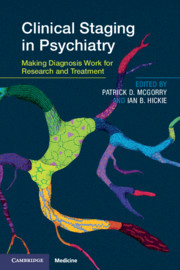Book contents
- Clinical Staging in Psychiatry
- Clinical Staging in Psychiatry
- Copyright page
- Contents
- Contributors
- Foreword
- Acknowledgements
- Section 1 Conceptual and Strategic Issues
- Section 2 Progress with Clinical Staging
- Chapter 5 The Utility of Clinical Staging in Youth Mental Health Settings
- Chapter 6 Neuroimaging and Staging
- Chapter 7 Staging of Cognition in Psychiatric Illness
- Chapter 8 Neuroinflammation and Staging
- Chapter 9 Bioactive and Inflammatory Markers in Emerging Psychotic Disorders
- Chapter 10 Electroencephalography and Staging
- Section 3 Novel Treatment Strategies
- Section 4 Novel Treatment Strategies
- Index
- Plate Section (PDF Only)
- References
Chapter 5 - The Utility of Clinical Staging in Youth Mental Health Settings
Neurobiological and Longitudinal Data from Sydney-Based Studies of Transdiagnostic Cohorts
from Section 2 - Progress with Clinical Staging
Published online by Cambridge University Press: 08 August 2019
- Clinical Staging in Psychiatry
- Clinical Staging in Psychiatry
- Copyright page
- Contents
- Contributors
- Foreword
- Acknowledgements
- Section 1 Conceptual and Strategic Issues
- Section 2 Progress with Clinical Staging
- Chapter 5 The Utility of Clinical Staging in Youth Mental Health Settings
- Chapter 6 Neuroimaging and Staging
- Chapter 7 Staging of Cognition in Psychiatric Illness
- Chapter 8 Neuroinflammation and Staging
- Chapter 9 Bioactive and Inflammatory Markers in Emerging Psychotic Disorders
- Chapter 10 Electroencephalography and Staging
- Section 3 Novel Treatment Strategies
- Section 4 Novel Treatment Strategies
- Index
- Plate Section (PDF Only)
- References
Summary
For over a decade a transdiagnostic clinical staging framework for youth with anxiety, mood and psychotic disorders (linked with measurement of multidimensional outcomes), has been utilised in over 8,000 young people presenting to the enhanced primary (headspace) and secondary care clinics of the Brain and Mind Centre of the University of Sydney. This framework has been evaluated alongside a broad range of other clinical, neurobiological, neuropsychological, brain imaging, circadian, metabolic, longitudinal cohort and controlled intervention studies. This has led to specific tests of its concurrent, discriminant and predictive validity. These extensive data provide strong preliminary evidence that: i) varying stages of illness are associated with predicted differences in a range of independent and objectively measured neuropsychological and other biomarkers (both cross-sectionally and longitudinally); and, ii) that earlier stages of illness progress at variable rates to later and more severe or persistent disorders. Importantly, approximately 15-20% of those young people classed as stage 1b or ‘attenuated’ syndromes at presentation progress to more severe or persistent disorders. Consequently, this cohort should be the focus of active secondary prevention trials. In clinical practice, we are moving to combine the staging framework with likely pathophysiological paths (e.g. neurodevelopmental-psychotic, anxiety-depression, circadian-bipolar) to underpin enhanced treatment selection.
Keywords
- Type
- Chapter
- Information
- Clinical Staging in PsychiatryMaking Diagnosis Work for Research and Treatment, pp. 81 - 102Publisher: Cambridge University PressPrint publication year: 2019
References
- 3
- Cited by

